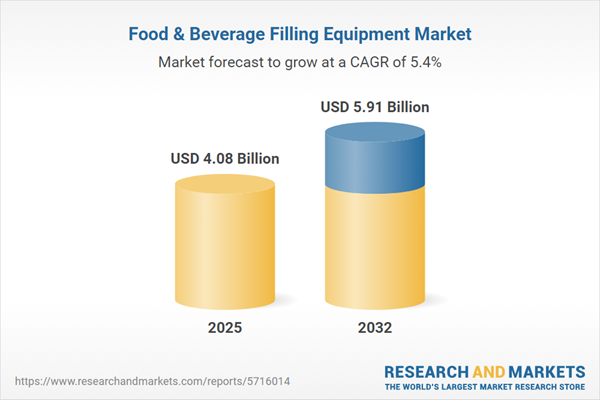Speak directly to the analyst to clarify any post sales queries you may have.
The food and beverage filling equipment market is undergoing significant transformation as senior leaders embrace smart technologies, agile processes, and resilient supply chains. Decision-makers now prioritize operational flexibility and integrated digital systems to strengthen growth and manage regulatory shifts.
Market Snapshot: Food & Beverage Filling Equipment Market
The global food and beverage filling equipment market is valued at USD 3.88 billion in 2024, with projected growth to USD 4.08 billion in 2025 and USD 5.91 billion by 2032. This expansion reflects a 5.37% compound annual growth rate (CAGR). Ongoing investment in automation, real-time digital integration, and advanced data platforms is shaping operational strategies. Manufacturers are evolving to meet stricter compliance standards and increasing pressure for production precision. Flexible filling systems now drive agile production models, enabling industry players to adapt to diverse regulatory environments, fragmented global markets, and changing supply chain dynamics. Digital transformation is integral for building operational resilience and is a key lever in managing multifaceted global requirements.
Scope & Segmentation
- Equipment Types: Granular, liquid, paste, powder, and solid filling systems enable manufacturers to produce a diverse range of products and adapt to evolving consumer trends throughout the calendar year.
- Automation Levels: Manual, semi-automatic, and fully automatic setups allow businesses to tailor production lines to both current operations and future scalability, supporting strategic expansions.
- Filling Mechanisms: Gravity, net weight, piston, rotary, time-pressure, and vacuum-based systems address varying product consistencies and align with global packaging requirements, ensuring process compliance and versatility.
- Capacities: High-speed, medium-speed, and low-speed equipment meets the demands of bulk producers, smaller batch manufacturers, and niche brands, promoting optimal filling reliability.
- Container Types: Compatibility spans glass bottles, PET bottles, aluminum cans, tin cans, cartons, jars, cups, pouches, and sachets, supporting a variety of packaging formats to suit market and regulatory preferences.
- End-Use Industries: Food, beverage, chemical, pharmaceutical, cosmetics, personal care, and cleaning product sectors adopt these systems to achieve regulatory and performance objectives.
- Regional Coverage: The Americas, EMEA, and Asia-Pacific regions each present distinct regulatory environments and adoption patterns, which shape competitive and investment strategies across the marketplace.
- Leading Companies: Krones AG, Tetra Pak International SA, GEA Group AG, Syntegon Technology GmbH, and KHS GmbH establish industry benchmarks and provide templates for successful technology deployment.
Key Takeaways for Senior Decision-Makers
- Digital connectivity enhances operational oversight and responsiveness to regulatory changes, building an agile foundation for complex supply chains.
- Predictive maintenance and analytics-focused solutions increase equipment uptime, advance asset reliability, and support high-performance production environments.
- Efficiency projects with sustainability considerations help meet growing stakeholder expectations and foster trust with clients and regulatory bodies.
- Local and regional sourcing approaches benefit companies working to offset increased supply chain complexity and reduce exposure to global disruptions.
- Modular system architectures assist in the rapid introduction of new product variations and help manage capital outlays, especially in unpredictable markets.
- Effective integration of advanced technologies is achieved through partnerships with technology providers and skilled teams, securing long-term operational strength.
Tariff Impact on Sourcing and Supply Chains
Anticipated U.S. tariffs in 2025 are causing companies to reassess sourcing models and supplier networks. Senior leaders increasingly adopt nearshoring and regional diversification to safeguard resilience. Digital trade management tools are also being implemented, enabling real-time supplier visibility, streamlining transactional efficiency, and ensuring compliance with shifting regulatory scenarios.
Methodology & Data Sources
This market analysis is grounded in a triangulated methodology, combining subject matter expert interviews, comprehensive literature reviews, and scenario-based supply chain modeling. The approach equips senior decision-makers with validated insights to navigate market volatility and support agile organizational planning.
Why This Report Matters
- Segment-level benchmarking empowers executives to drive informed investment, technology, and positioning strategies amidst changing industry landscapes.
- Scenario and risk assessments facilitate preparedness for regulatory and market shifts, allowing proactive mitigation of operational disruptions.
- Regional analysis provides senior leaders with strategic direction for investment and supply chain adaptation, aligning decisions with both local and global priorities.
Conclusion
Sustained focus on technology adoption and operational excellence remains essential for enduring success. This analysis delivers practical intelligence that empowers senior leadership to strengthen resilience and harness new opportunities in the evolving food and beverage filling equipment market.
Additional Product Information:
- Purchase of this report includes 1 year online access with quarterly updates.
- This report can be updated on request. Please contact our Customer Experience team using the Ask a Question widget on our website.
Table of Contents
3. Executive Summary
4. Market Overview
7. Cumulative Impact of Artificial Intelligence 2025
Companies Mentioned
The companies profiled in this Food & Beverage Filling Equipment market report include:- Krones AG
- Tetra Pak International SA
- GEA Group AG
- Syntegon Technology GmbH
- KHS GmbH
- Alfa Laval AB
- Coesia S.p.A.
- SIG Group AG
- Ishida Co., Ltd.
- IMA Industria Macchine Automatiche S.p.A.
- Sidel S.P.A.
- Guangzhou TECH-LONG Packaging Machinery Co., Ltd.
- Accutek Packaging Company, Inc.
- Zhangjiagang Micmachinery.co.,ltd
- Dalian Zhongtong Food Machinery Co., Ltd
- SHIBUYA CORPORATION
- Federal MFG LLC.
- Ave Technologies S.r.l.
- Pattyn Group
- COMAC S.p.A.
- Adelphi Packaging Machinery
- All-Fill Inc.
- PESTOPACK
- HANGZHOU YOUNGSUN INTELLIGENT EQUIPMENT CO., LTD.
- SMI S.p.A.
- Barry-Wehmiller Companies, Inc.
Table Information
| Report Attribute | Details |
|---|---|
| No. of Pages | 195 |
| Published | October 2025 |
| Forecast Period | 2025 - 2032 |
| Estimated Market Value ( USD | $ 4.08 Billion |
| Forecasted Market Value ( USD | $ 5.91 Billion |
| Compound Annual Growth Rate | 5.3% |
| Regions Covered | Global |
| No. of Companies Mentioned | 27 |









